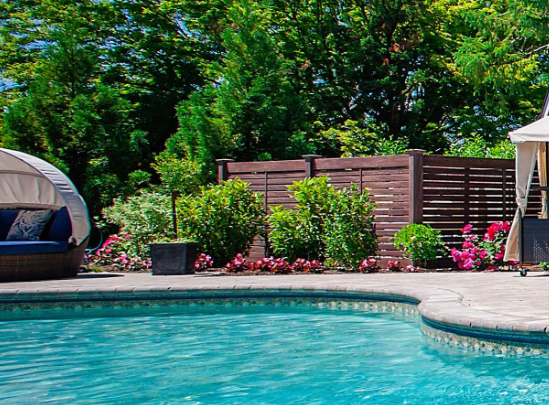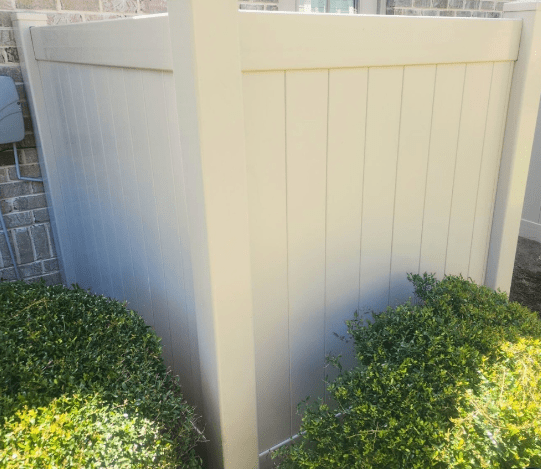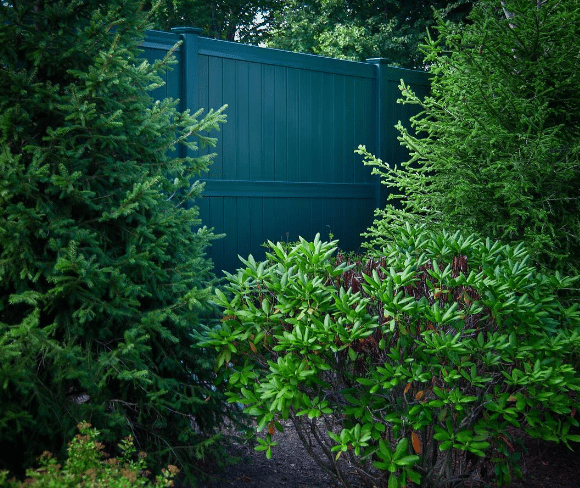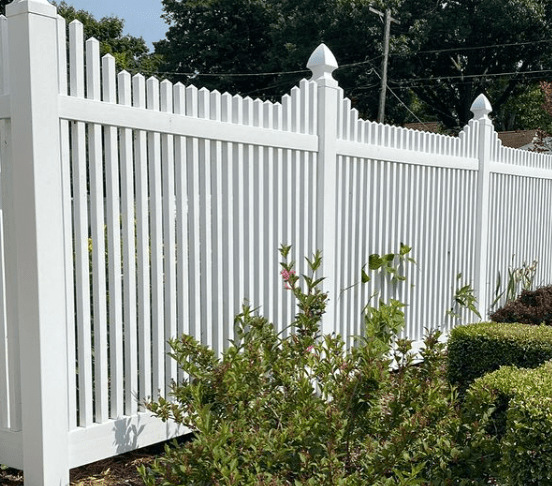Vinyl fence landscaping is a unique and rewarding way to enhance outdoor space. Adding Plants Along a Vinyl Fence can create a lush border that adds depth, texture, and interest to your yard.
Over 50% of American homeowners have vinyl fencing. It’s a popular choice due to its durability, low maintenance, and versatility. But your vinyl fence can do more than just mark your yard. With the right plants, you can turn it into a breathtaking garden that adds interest and function to your outdoor space.
People Also Read: Chemical Plants Do Efficient Reactions – Discover Their Secret
Key Takeaways
- Vinyl fences offer a versatile and low-maintenance canvas for growing a variety of plants.
- Carefully selecting the right plants can transform your fence into a stunning, living work of art.
- Proper soil preparation and maintenance are crucial for ensuring your fence-line plants thrive.
- Vines, shrubs, and perennials can all be successfully grown along a vinyl fence.
- With the right techniques, you can create a beautiful, lush garden that enhances your outdoor space.
Embracing the Beauty of Vinyl Fence Gardens
Vinyl fence landscaping is a unique and rewarding way to enhance your outdoor space. By adding plants for vinyl fences, you can create a lush border that adds depth, texture, and interest to your yard. Explore how growing vines on vinyl fences can turn simple vinyl fence gardens into beautiful features.

Advantages of Growing Plants Along Vinyl Fences
Planting along your vinyl fence line offers numerous benefits, boosting privacy, enhancing your home’s curb appeal, and creating a more welcoming and attractive outdoor space. The combination of fence line planting with a durable vinyl fence creates a beautiful landscape that makes your yard look cohesive and harmonious.

Transforming Ordinary Fences into Living Art
Vinyl fence landscaping can transform a plain fence into a living part of your yard. By choosing the right plants for vinyl fences, like colorful vines or greenery, you can create a stunning display that adds character and beauty to your outdoor area. The mix of vinyl fence and growing vines on vinyl fences creates a natural, eye-catching look, turning your fence into a piece of living art.

Selecting the Right Plants for Vinyl Fences
Creating a lush vinyl fence garden begins with picking the right plants. You might want vines that cascade, shrubs that catch the eye, or perennials that are easy to care for. The right plants can turn a simple fence into a stunning piece of art.
When choosing plants for your fence, keep these tips in mind:
- Climate and Sunlight Exposure: Consider your fence’s location, taking into account the temperature, rainfall, and sunlight it gets. Pick plants that match your area’s conditions.
- Growth Habits and Size: Look at how big the plants will get and how they grow. Ensure they won’t overgrow your fence or become too unruly. Choose plants that fit well with your vinyl fence.
- Maintenance Requirements: Select plants that are easy to care for. Look for ones that don’t need much water, are resistant to diseases, and don’t require a lot of pruning or staking.
By considering these factors, you can create a vinyl fence garden that looks great and grows well. Use the variety of plants for vinyl fences to show off your creativity!
Preparing the Soil for Fence Line Planting
Getting your soil right is crucial for a thriving vinyl fence garden. Before planting, ensure your soil is ready for your fence line planting, gardening along fences, and vinyl fence landscaping projects.

Amending the Soil for Optimal Growth
To give your plants the best start, you need to improve the soil along your fence. Start by testing the soil to determine its pH level and nutrient content. Then, add organic matter like compost or well-rotted manure to enhance soil structure and fertility. This will help your plants grow strong roots and flourish in their new home.
Considering Drainage and Irrigation Needs
Ensure the soil along your fence line planting drains well to avoid waterlogging and root rot. If needed, install a drainage system or raise the beds. Think about the watering needs of your gardening along fences and vinyl fence landscaping plants. Decide if you need a dedicated watering system or if hand-watering will work. Consider the microclimates your vinyl fence creates. They might change the water needs of your plants.
By preparing the soil and addressing drainage or irrigation issues, you’ll create a lush fence line planting that transforms your ordinary vinyl fence into a beautiful living art piece.
How to Grow Plants Along a Vinyl Fence
Ready to turn your vinyl fence into a lush garden? You’re in the right place! Growing plants along a vinyl fence requires planning and care, but the outcome is well worth the effort. Let’s explore how to create your own gardening along the fences masterpiece.
- Pick the Right Plants: Select plants that fit the fence line’s conditions, like sun, soil, and space. Section 3 of this guide provides more information on plant selection.
- Prepare the Soil: Make the soil along the fence suitable for plants. This might involve adding compost, fertilizer, or adjusting the pH level.
- Install a Trellis or Support System: Some plants need a trellis or support to climb and grow along the fence.
- Plant Your Selections: Plant your chosen how to grow plants along a vinyl fence plants, spacing them based on their mature size.
- Water and Maintain: Keep your plants watered and maintained by pruning, weeding, and addressing any pest or disease problems.
By following these steps, you’ll create a beautiful gardening along fences display that enhances your outdoor space’s beauty and function. Use vinyl fence landscaping to showcase your creativity.
Gardening Along Fences: Vine Selections
Adding vibrant vines to your vinyl fence is a great way to add vertical interest and make your fence look lush and eye-catching. There are many options for vines that work well with fences. Let’s explore some of the best choices.

Vibrant Vines for Vertical Interest
The climbing hydrangea is a top pick for vinyl fences. It has stunning white blooms that cascade down beautifully. For a splash of color, try the trumpet vine with its bright orange or red flowers. The Virginia creeper is also an excellent choice, with its rich green leaves turning red or purple in fall. If you want something more delicate, the clematis is perfect. It comes in many colors, from soft pastels to bold shades. The morning glory is another beautiful option, with its trumpet-shaped flowers opening every morning.
| Vine | Characteristics | Growth Habits |
|---|---|---|
| Climbing Hydrangea | Stunning white blooms, lush foliage | Vigorous grower, can reach up to 30 feet |
| Trumpet Vine | Bright orange or red tubular flowers | Rapid growth, can be aggressive |
| Virginia Creeper | Rich green foliage, vibrant fall colors | Self-clinging, can grow up to 50 feet |
| Clematis | Wide range of bloom colors, delicate flowers | Requires support, grows up to 12 feet |
| Morning Glory | Trumpet-shaped blooms, vibrant colors | Rapid growth, can self-seed |
When picking vines for your fence, consider their growth, bloom times, and care needs. This will help you create a beautiful and thriving display along your fence.
Fence Landscaping Ideas: Shrubs and Perennials
Creating a beautiful vinyl fence garden is easy with shrubs and perennials. They add depth, texture, and interest all year. Vines are great for vertical drama, but shrubs and perennials make your fence line look cohesive and beautiful.
Shrubs are excellent for fencing. Choose evergreen shrubs like azaleas or boxwoods for a green look all year. For seasonal color, try hydrangeas or viburnums.
Perennials offer many options for your fence garden. Daylilies, coneflowers, and Russian sage are good choices. They change with the seasons, keeping your garden interesting.
When picking plants, consider their size, sun needs, and upkeep. The right plants make your garden lush and beautiful. They highlight your vinyl fence and make your yard more interesting.
Using shrubs and perennials, you can turn your vinyl fence into a stunning garden. It shows off your gardening skills and becomes a yard highlight.
Vinyl Fence Plant Selection: Factors to Consider
Choosing the right plants for your vinyl fence is key. You need to think about plant height, spread, and how much care they need. These factors help make your vinyl fence garden look great and stay healthy.
Plant Height and Spread
The size of your plants affects how your fence garden looks and works. Pick plants for vinyl fences that match your fence’s size. This way, your garden won’t look too big or too small.
Taller plants can make your fence look lush and green. On the other hand, smaller plants can hug the ground. Make sure you know how big your plants will get to fit your space well.
Maintenance Requirements
Consider how much care your plants need. Some plants need a lot of pruning or other care to stay pretty. Choose plants for vinyl fences that are easy to care for. This makes gardening easier for you.
By picking the right plants, you can have a beautiful vinyl fence garden. It will make your outdoor area look great without a lot of work.
Caring for Your Vinyl Fence Garden
Maintaining a thriving gardening along fences requires ongoing care. Whether you’ve picked vibrant vines, lush shrubs, or eye-catching perennials, keeping your vinyl fence landscaping in top shape is key. It ensures your plants keep growing and add beauty to your outdoor space.
Watering, Pruning, and Pest Control Tips
To keep your how to grow plants along a vinyl fence healthy and vibrant, follow these essential tips:
- Watering: Establish a regular watering schedule, adjusting as weather and plant needs change. Don’t overwater, as it can cause root rot and other problems.
- Pruning: Prune your plants regularly to maintain their shape, promote healthy growth, and prevent damage to the fence. Use sharp, clean tools and respect the plant’s natural growth.
- Pest Control: Watch for pests or diseases and address them promptly using eco-friendly methods. This helps your plants stay healthy and pest-free.
By following these simple yet effective gardening along fences tips, you’ll enjoy a lush and vibrant vinyl fence landscaping that brings joy to you for many years.
Recap: How To Grow Plants Along a Vinyl Fence
Now you know how to grow plants along your vinyl fence. You can pick from vibrant vines, eye-catching shrubs, or stunning perennials. Your fence will turn into a beautiful part of your outdoor space.
Start enjoying your vinyl fence garden. With the right plants and care, your fence will become a stunning feature. It will add depth and natural beauty to your property.
Be proud of your gardening skills. Let your creativity show in your fence-line display. It will bring joy and beauty to your outdoor space. The possibilities are endless with how to grow plants along a vinyl fence, gardening along fences, and vinyl fence landscaping.
Conclusion
With careful planning and a little TLC, you can transform your vinyl fence into a vibrant and beautiful garden. Remember, the key is to select the right plants for your climate and soil conditions, provide adequate support, and maintain a regular watering and pruning schedule.
FAQs
What are some of the best vines for growing along a vinyl fence?
Some of the best vines for growing along a vinyl fence include climbing hydrangea, trumpet vine, Virginia creeper, clematis, and morning glory. These vines offer a variety of colors, growth habits, and characteristics to suit different preferences and garden styles.
How do I prepare the soil for planting along a vinyl fence?
Start by testing your soil to determine its pH level and nutrient content. Then, amend the soil with organic matter like compost or well-rotted manure to improve its structure and fertility. This will help your plants establish strong roots and thrive.
What kind of support do vines need to grow along a vinyl fence?
Some vines, like clematis, require support to climb. You can use trellises, wires, or even attach them directly to the vinyl fence with ties or clips. Ensure the support is sturdy enough to handle the vine’s weight as it grows.
How often should I water plants growing along a vinyl fence?
Watering frequency depends on the type of plants you’ve chosen and the weather conditions. Generally, it’s best to water deeply but less frequently, allowing the soil to dry slightly between waterings. Avoid overwatering, which can lead to root rot.
How do I prune plants growing along a vinyl fence?
Pruning is essential to maintain the shape of your plants and promote healthy growth. The best time to prune depends on the specific plant. Generally, it’s advisable to prune after flowering to encourage new growth.
What are some common pests and diseases that affect plants growing along a vinyl fence?
Common pests include aphids, spider mites, and scale insects. Diseases can include powdery mildew, rust, and leaf spot.
How can I control pests and diseases in my vinyl fence garden?
Use eco-friendly pest control methods like insecticidal soap, neem oil, or diatomaceous earth. For diseases, consider fungicides or organic treatments like baking soda or copper spray.
What are some tips for creating a beautiful and thriving vinyl fence garden?
Choose plants that are well-suited to your climate and soil conditions. Ensure adequate sunlight exposure and provide appropriate support for climbing vines. Regularly water, prune, and monitor for pests and diseases.
Is it possible to grow vegetables along a vinyl fence?
Yes, you can grow vegetables like tomatoes, beans, cucumbers, and squash along a vinyl fence. Use trellises or supports to help the vegetables climb and grow vertically.
Are there any special considerations for growing plants along a vinyl fence in a hot climate?
Yes, in hot climates, it’s essential to choose plants that are drought-tolerant and can withstand high temperatures. Provide adequate watering, especially during the hottest months, and consider mulching around the plants to help retain moisture.
If you’re interested in learning more about tech news, feel free to visit my website: www.HowToGrowPlant.com.
